見えないごみ|藤元明
近年メディアで大きく取り上げられるようになった海ごみや海洋プラスチックという社会問題だが、実際本物を見る機会はほぼ無い。僕自身も海洋プラスチックごみの数値や写真など人伝ての情報に驚愕していたが、今回の展示を機に、海ごみが集中すると言われる長崎県の五島列島福江島と奈留島、石川県の能登半島西側と北側の海岸線をリサーチした。そこで実際に見聞きしたことを含め、率直に僕自身の感想を紹介したい。
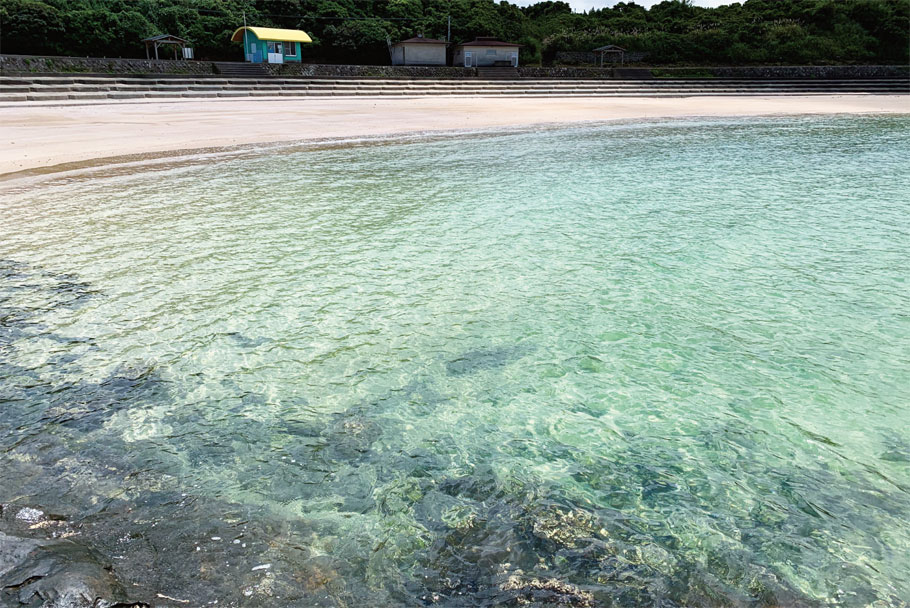

五島列島福江島でまず案内されたビーチにはごみ一つなく、水の透明度も申し分ない。しかし藪を抜けて偶然見つけた石がゴロゴロしている隣の浜では、大量の漂着ごみが放置されていた。その状況に地元の方も一緒に驚いたのだが、ここに海ごみ回収の本質がある。観光ビーチなどは人が訪れやすく、清掃も容易であり、地元収益に直結するので清掃するに値する。市役所も浜清掃の優先順位をハッキリと決めていて、投下される予算を人(観光客)が来ない場所に割振る余裕はない。そして清掃回収後のごみは基本的に焼却処理で、島で燃やせないものは本島(九州)に運ぶという。ごみが大量にある浜には大体ごみを焼いた痕がある。少しでも減らしたいと地元民がその場で燃やすのかもしれない。当然行政がなんらかの資源再生をしていると思っていたのだが、技術面では解決しつつも、コスト面の折り合いがつかず税金を無駄に使えないと諦めているという。一般の廃プラ再生事業者も、行政支援終了後に採算ベースに乗せられないということで、殆どの取組みは潰(つい)えているという。


聞き込み初日から「絶望」を感じ始めた。プラスチックの生産量は今も増加していて、海に流出する廃プラの量も比例して増える、それらは分解しないでどこかに浮いているか、細かくなりどこかに人知れず沈んでいるのか、未だに研究者にも見えていない。一方、福江島の海ごみに取組む高校生たちに、少し意地悪なこの「絶望」をどう思うかと質問してみた。彼らは既にこれは地元の海の問題ではなく、国際規模で取組まないと解決しないと分かりながらも、大人たちが汚した海を手の届く所から綺麗にし、その振る舞いを広げることで未来に繋げたいと語るのである。この話を聞いて尚、僕の感じる「悪者のいない絶望」はより深まり、漂着ごみを拾う気力も無くなった。アーティストとして自分は、現状を伝えること以外に無いのかと悶々としながら能登半島に向かった。
よりダイナミックに海ごみが展開する能登半島のフィールドワークの最後に、三代海女をしているという方の話では「特に漁に影響はない」「子供の頃からこんなもので、近年海ごみが増えているという感覚はない」「清掃してもすぐに元に戻るし」と普通に言う。ここで僕はハッとなった。我々陸の人間は、海は綺麗なところで、いつかごみはなくなるという幻想の中にいたのだと。実際は近年ごみが増えたのではなく、我々の快適な営みのしわ寄せをずーっと海に溜めていて、海側では何も解決できない。見えて触れる所は綺麗に出来ても、見えないごみはこれからも存在するのだと。この読み違いに気がついたことで開けた。平和な時は環境保全を語るが、戦争や災害などの社会喪失が起こると環境の話は二の次になる。今の海ごみブームもいつどうなるか分らない、ただ近年ごみを減らそうという国際目標が出来始めて、以前より社会意識に変化はある。自分のやるべきことは、やはりこれまでの活動同様、この「陸の海ごみ」というコンセプトを持ち込み様々な領域を超え、表現に落とし込むことで社会と繋げることである。純粋に問題の原理部分をえぐり出そうとするアーティストに、本質を代弁してもらいたいと色々な人が損得を超え協力してくれた。これがアートがなし得る強みであり、皆様に感謝したい。
実際のところ日本の長大な海岸線で海ごみが集中する場所に訪れるのは、知り合い伝ての具体的な情報と協力者がいなければ難しい。裏を返せばそれは、海全体にごみが散乱しているわけではなく、探さなければ見つからないということでもある。この発見困難な物的証拠とその状況描写をギャラリーで晒す行為は、自身の体験(絶望)をシェアすることであり、それを受けてそれぞれに生まれる意識は噂話のレベルを超え、それぞれの行動に繋がると信じるのである。
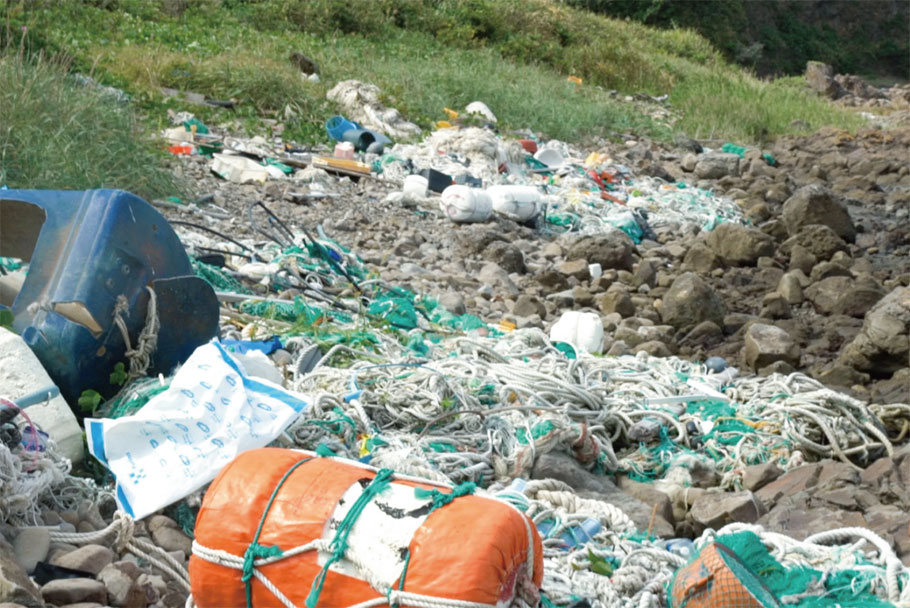
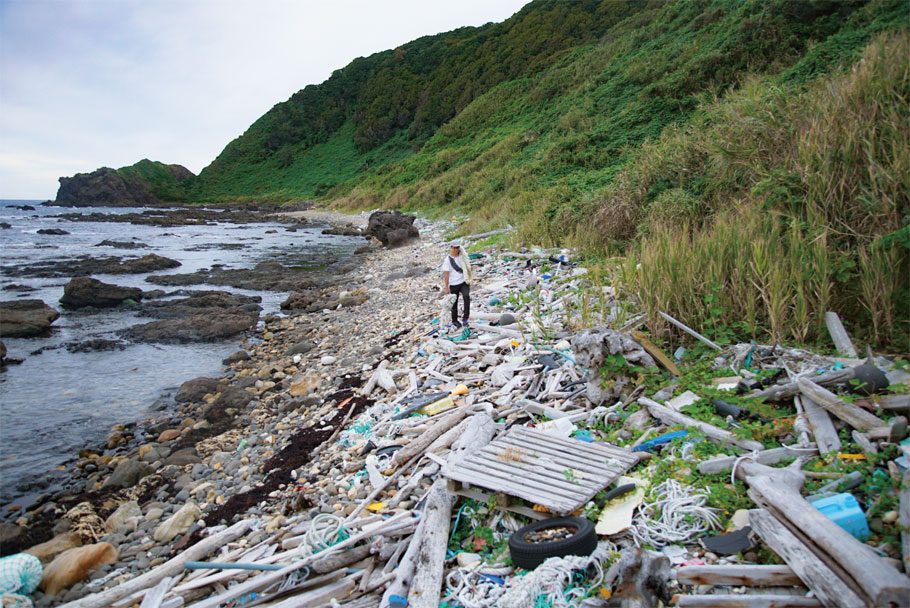
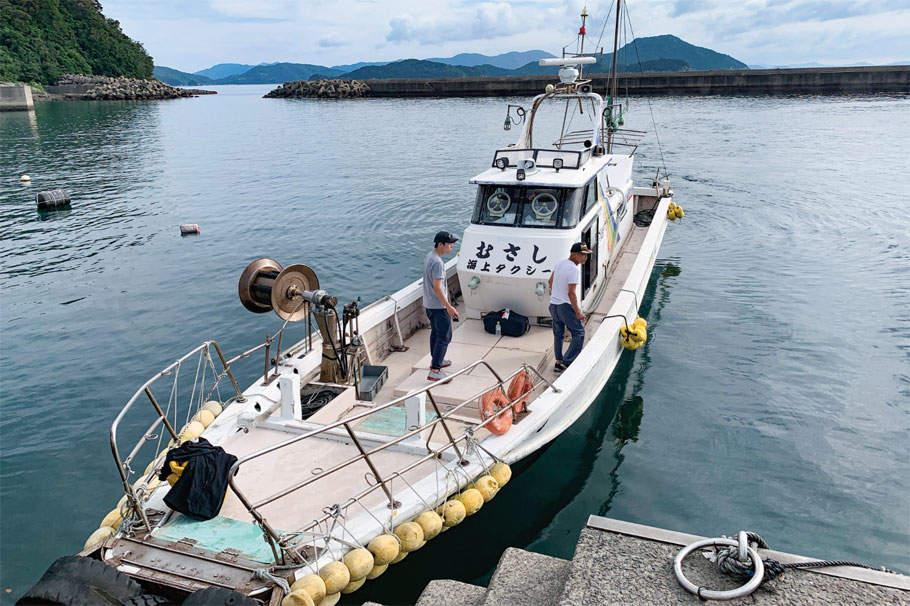

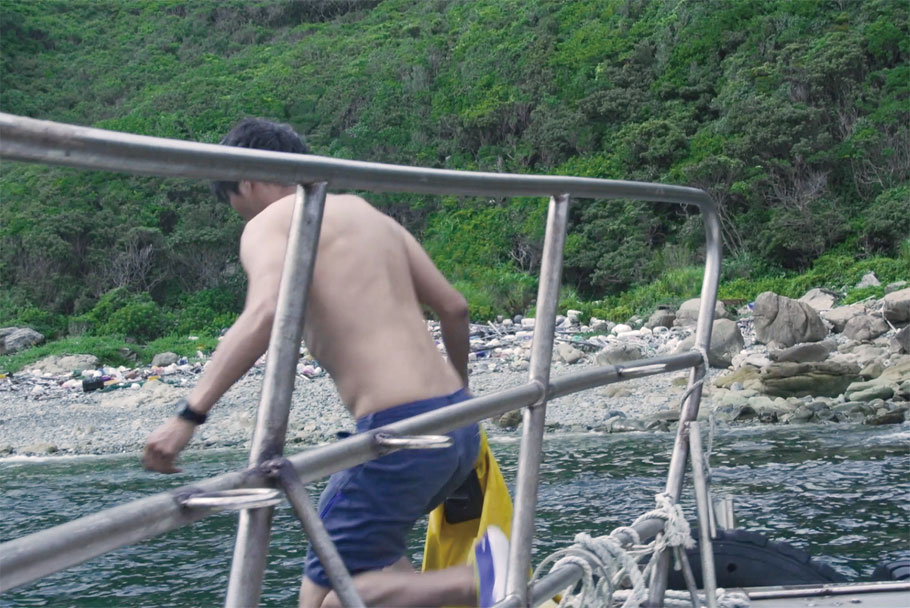
藤元明
1975 年東京生まれ。東京藝術大学美術学部大学院デザイン専攻修了。FABRICA
(イタリア)に在籍後、東京藝術大学先端芸術表現科非常勤助手を経てアーティストとして活動。都市における時間的/空間的余白を活用するプロジェクト「ソノ アイダ」を主催。人間では制御出来ない社会現象をモチーフとして、様々な表現手法で作品展示やアートプロジェクトを展開。主なプロジェクトに「TOKYO 2021」「NEW RECYCLE®」、広島-New York で核兵器をテーマに展開する「Zero Project」など。2016 年より開始した「2021」プロジェクトは現在も進化中。
Invisible garbage | Akira Fujimoto
Though marine garbage and marine plastic are social issues that have been getting a lot of media attention in recent years, there are actually very few opportunities to see the real thing. Having been astonished by the numbers, photos, and other information about marine plastic that I had been exposed to through others, I took advantage of this exhibition to do my own research on the west and north coasts of the Noto Peninsula in Ishikawa Prefecture, and in the Goto Islands—Fukue Island and Narushima Island—of Nagasaki Prefecture, places where marine garbage is said to be concentrated. I would like to offer my frank impressions of what I saw and heard in these places.
The first beach I was taken to, on Fukue Island in the Goto Islands, was completely free of litter, and the water was perfectly clear. However, the rocky beach next to it, which I found by accident by passing through a thicket, had a huge amount of marine litter. The local people were just as surprised as me, but here was the essence of the marine garbage collection issue. Beaches that are sightseeing spots have many visitors, are easy to clean, and are worth keeping clean because they are directly linked to local revenue. City hall is clear about the prioritizing of beach cleaning, and cannot afford to allocate money to places where people (tourists) do not come. The garbage collected after clean-up is incinerated for the most part, and anything that cannot be burned on the island is transported to the main island (Kyushu). On beaches where there are large amounts of garbage, there are usually traces of burned garbage as well. It may be that local residents, in an effort to do what little they can to reduce the amount of garbage, burn some of the garbage on the spot. I had thought the government would naturally be conducting some sort of resource recycling, but while such solutions are becoming technologically feasible, cost remains an issue, and they have been shelved on the grounds that taxpayers’ money cannot be wasted. Moreover, nearly all the efforts of waste plastic recycling companies collapsed after the termination of administrative support due to an inability to achieve profitability.
From my first day of interviews, I was already starting to feel “despair.” Plastic production is still increasing, and the amount of waste plastic flowing out to the sea is also increasing proportionally, and even researchers are still not clear about where all that non-biodegradable plastic goes—whether it is floating somewhere or has broken up into fine particles and sunk into some hidden depths. I asked the high school students tackling the marine garbage on Fukue Island what they thought of this slightly malicious “despair.” While they were perfectly aware that this is no longer a local sea problem but rather an issue that can only be resolved if dealt with on an international scale, they spoke of their desire to start from where they can, by cleaning this sea that has been polluted by adults, with the hope that their actions will spread, and have some positive effect on the future. On hearing their words, I felt an even deeper sense of “despair with no one to blame," and lost the will to pick up marine garbage. I headed to Noto Peninsula wondering if there was anything for me as an artist other than to convey the current situation.
At the end of my fieldwork on Noto Peninsula, where marine garbage washes up more dynamically, I spoke to a third-generation shell diver who noted in a matter-of-fact tone, “It doesn't have any particular impact on fishing,” “It's been like this since I was a child, and I don't get the impression that marine garbage has increased in recent years,” and “Even if you clean it up, it immediately goes back to the way it was.” That was when it hit me. We humans have been under the illusion that the sea is clean and beautiful, and that someday garbage will disappear. In fact, the amount of waste has not increased in recent years; rather, we have simply swept our efforts to maintain our comfortable lives out to the sea, but this is not a problem we can solve in the sea. Even if we succeed in cleaning up the places we can see and touch, garbage will continue to exist in the places we can't see. It was an eye-opening realization. In times of peace, we talk about environmental conservation, but when social losses such as wars and disasters occur, the environment is no longer a priority. I don't know what will happen with the current surge of interest in marine garbage, but it does seem that, with the establishment of reducing garbage as an international goal in recent years, social awareness has changed. My job is to form a connection to society by bringing in the concept of “marine garbage of land” and put it—as I have done in the past—in a form of expression that transcends disciplines. A variety of people, who wanted an artist trying to get to the core of the problem to speak for them about the essence of the issue, cooperated with me with no consideration of their own personal gain or loss. This is the strength of art, and I want to express my gratitude to all these people.
In fact, without specific information obtained from personal networks and people who are willing to cooperate, it is difficult to visit places on Japan's long coastline that have a high concentration of marine garbage. In other words, garbage is not scattered all over the sea; rather, one has to look for it in order to find it. By exposing this hard-to-find physical evidence, and descriptions of it, in a gallery, I am sharing my own experience (despair) in the belief that the thoughts it arouses in others will go beyond the level of gossip and lead to individual action.
Akira Fujimoto
Born in Tokyo in 1975. Studied at the Graduate School of Design, Tokyo University of the Arts. Became active as an artist after working at FABRICA (Italy) and as an assistant teacher of Intermedia Art at the Tokyo University of the Arts. Hosted “Sono Aida,” a project that utilizes temporal and spatial spaces in the city. Using a variety of media, his exhibitions and art projects have as their motif social phenomena that are beyond the control of people. His major works include “TOKYO 2021,” “NEW RECYCLE®,” and “Zero Project,” a Hiroshima-New York project on the theme of nuclear weapons. “2021,” a project he started in 2016, is still evolving.